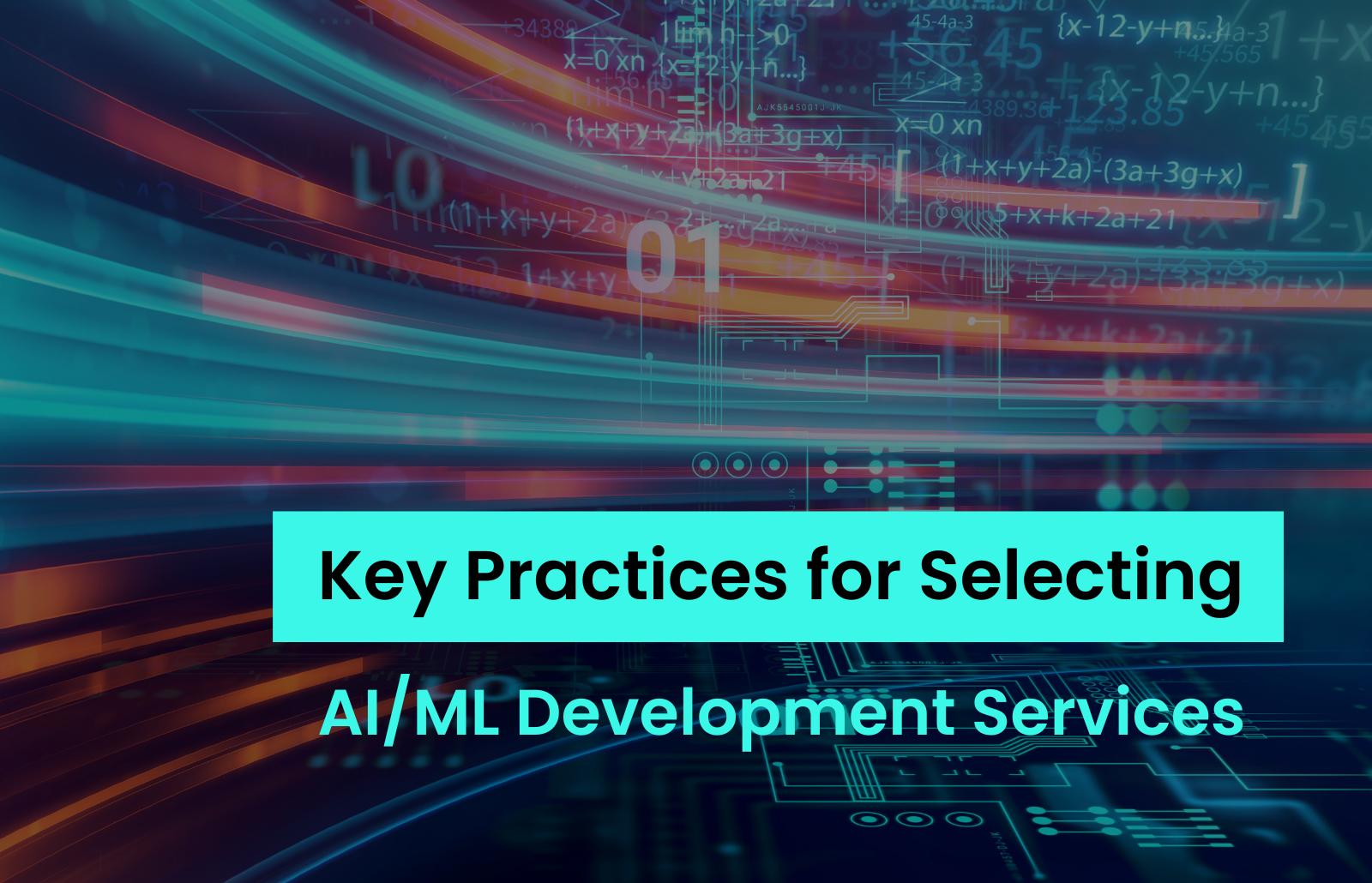In the rapidly evolving landscape of artificial intelligence and machine learning, organisations encounter a multitude of challenges and opportunities as they embark on their projects. Defining clear requirements, assessing provider expertise, evaluating security standards, and understanding development methodologies are critical steps that underpin success. As businesses strive to harness the transformative power of AI, the significance of structured approaches becomes increasingly apparent. This article explores the essential components of launching a successful AI/ML initiative, providing insights and strategies to help organisations navigate the complexities of this dynamic field.
1. Define Your AI/ML Project Requirements
To effectively define your requirements for AI/ML development services, engaging all relevant stakeholders early in the process is essential. Collecting insights from these individuals aids in aligning the initiative with their needs and expectations. Employ techniques such as user stories and use case scenarios to articulate specific functionalities and performance metrics clearly.
Consider the data requirements thoroughly, including sources, quality, and volume, as these factors significantly influence the success of the endeavour. Establishing clear success criteria is crucial for measuring effectiveness post-implementation. For instance, when developing a predictive model, define metrics such as accuracy, precision, and recall to evaluate its performance against established business goals.
Statistics indicate that 44.2% of companies possess well-established AI ethics and data governance policies, emphasising the significance of organised methods in AI initiatives. Furthermore, as AI adoption continues to rise, businesses increasingly recognise its benefits for cost reduction and enhanced decision-making, making the need for clearly defined requirements in AI/ML development services critical. Involving stakeholders not only improves alignment but also fosters a cooperative atmosphere that can yield creative solutions and favourable results.
As Jack Shepherd, Co-Founder of Social Shepherd, notes, “Of those businesses that use AI in the UK, about 40% purchase external AI solutions, and another 40% develop AI technology in-house.” This insight underscores the necessity of defining requirements to navigate the current market dynamics effectively. Additionally, with an expected increase of 1 million jobs in the AI field, the importance of well-defined requirements to support this expansion cannot be overstated.
For example, the retail sector is projected to see significant growth in AI applications, with businesses leveraging AI expected to outperform competitors. This demonstrates the practical advantages of clearly defining the requirements for AI/ML development services. However, it is also essential to be aware of common pitfalls in this process, such as failing to involve all relevant stakeholders or neglecting to establish clear success criteria, which can hinder success. Tackling challenges like delays in response time by utilising AI agents can further improve customer experience and operational efficiency, making it essential to consider these factors during the definition phase.
2. Assess Provider Expertise and Service Offerings
To effectively evaluate potential AI/ML development services, begin by thoroughly examining their portfolios to identify previous works that align with your specific requirements. Focus on case studies that showcase their success in delivering AI/ML development services, particularly within your industry. For instance, Zartis’s collaboration with Kaluza, an intelligent platform ecosystem powering the future of energy, exemplifies how tailored team augmentation can enhance platform development with skilled engineers in cloud operations and microservices. Assessing such case studies provides insights into a supplier’s ability to address industry-specific challenges.
Furthermore, consider the supplier’s method of collaboration and communication, as these factors significantly influence project outcomes. Engaging with references and collecting feedback from past clients will yield valuable insights into their satisfaction with the service offerings and the effectiveness of the solutions provided. Testimonials from clients serve as social proof of the supplier’s effectiveness and reliability.
As the demand for AI solutions continues to rise, with forecasts suggesting that global spending on AI will exceed $500 billion by 2027, it is crucial to ensure that your selected supplier provides quality AI/ML development services and has a proven track record in the tech industry. Notably, 41% of marketing practitioners plan to leverage generative AI for automating content creation, highlighting the growing reliance on AI capabilities across sectors. Moreover, half of the respondents who reported generative AI use in HR noted a reduction in costs, underscoring the potential financial benefits of selecting the right provider.
Additionally, with 29.9% of 18-25 year olds using virtual assistants weekly, it is evident that AI technologies are becoming increasingly integral to everyday operations. The significant impact of artificial intelligence on business environments necessitates ethical practices and regulatory structures, making it essential to choose a trustworthy technology supplier. By emphasizing these evaluation standards and acknowledging Zartis’s proficiency in custom software creation and technology advisory, you can empower your organization to leverage the full capabilities of artificial intelligence and machine learning technologies.
3. Evaluate Security and Compliance Standards
When assessing the safety and compliance standards of potential AI/ML development services, it is essential to thoroughly examine their data protection policies and practices. Begin by confirming their adherence to relevant regulations such as GDPR, HIPAA, or CCPA, which vary by industry. Evaluate their approaches to data encryption, access controls, and incident response plans to ensure strong protective measures are in place. Furthermore, confirm if they have experienced third-party evaluations or hold certifications such as ISO 27001, which demonstrate a strong dedication to upholding high safety standards. Routine evaluations of their compliance documentation are crucial, as is making sure they have a clear process for addressing any vulnerabilities that may arise during the project.
A real-world example of the implications of compliance can be seen in the case of Neuro-sama, an AI-powered VTuber who faced a temporary ban on Twitch due to hateful conduct. This incident underscores the importance of understanding risks in AI adoption, particularly regarding compliance with platform regulations. Furthermore, the challenges businesses face when implementing AI agents can be mitigated by adopting a hybrid approach, where routine inquiries are handled by AI while complex issues are escalated to human agents, ensuring accurate and empathetic support.
To effectively evaluate the security standards of AI/ML providers, organisations should consider the following steps:
- Confirm adherence to GDPR, HIPAA, or CCPA regulations.
- Assess data encryption, access controls, and incident response strategies.
- Verify third-party audits and relevant certifications.
- Conduct regular reviews of compliance documentation.
- Ensure transparency in addressing security vulnerabilities.
The case study titled “International Cooperation in Cybersecurity” highlights the necessity for coordinated efforts among organisations to address compliance needs and complex threats. Many organisations report improved collaboration and threat detection capabilities compared to previous years, yet they still face challenges in determining their focus areas amidst rapid technological changes.
Given the rapid evolution of AI technology, organisations must not rush into adopting generative AI without a clear understanding of these risks, as highlighted by the growing global AI cybersecurity market, projected to expand from $22.4 billion in 2023 to $60.6 billion by 2028, with a compound annual growth rate of 21.9%. This underscores the importance of strategic planning in AI adoption, particularly in light of the complex compliance landscape.
By adhering to these guidelines and utilising insights from events such as the Zartis AI Summit 2023, organisations can more effectively navigate the compliance landscape and make informed choices regarding their AI/ML development services.
4. Understand the Development Process and Methodologies
When selecting AI/ML development providers, it is essential to delve into their development methodologies and processes. The two predominant approaches are Agile and Waterfall:
- Agile: Focuses on iterative development and flexibility, allowing teams to adapt to changes quickly.
- Waterfall: Follows a linear progression, which can lead to delays—often extending delivery timelines by up to 25%.
Understanding how potential partners manage project workflows, including sprint planning, progress tracking, and stakeholder communication, is crucial for ensuring alignment with your project goals.
Moreover, the effectiveness of Agile methodologies in AI/ML development is underscored by the fact that 34% of organisations face resistance to change when adopting Agile, highlighting the need for a supportive culture. In contrast, 29% report insufficient training as a barrier, and 26% struggle with traditional Waterfall approaches. This context emphasises the importance of selecting a provider that not only offers AI/ML development services but also fosters an environment conducive to its success. As Jordan Jackson, a senior service delivery strategist at OTM, observes, “If your stakeholders aren’t engaged in the direction when they ought to be, your initiative could fail.”
Additionally, consider the Agifall methodology, which combines elements of both Agile and Waterfall approaches:
- Maintains a clear project scope while being flexible enough to adapt to changes.
- Particularly useful for clients who cannot engage in daily or weekly communications.
- Focuses on alignment and expectation management, resulting in successful outcomes.
Inquire about their strategies for testing and validation, as these are critical to ensuring that developed models meet quality standards prior to deployment. Effective model evaluation techniques, such as cross-validation and the use of performance metrics, are vital for assessing model effectiveness. Furthermore, conducting pilot tests before a full-scale rollout is essential; this allows businesses to evaluate performance, accuracy, and customer satisfaction, ensuring that AI agents remain effective. By prioritising these aspects and being aware of common pitfalls in adopting these methodologies, you can enhance the likelihood of successful project outcomes in your AI/ML development services, which reinforces the importance of understanding these methodologies for achieving your project goals.
Conclusion
Successfully implementing AI and machine learning initiatives demands meticulous attention to several key components. Defining clear project requirements is paramount for aligning stakeholder needs and establishing success criteria. Early engagement with relevant parties fosters collaboration, leading to effective, tailored solutions.
Equally crucial is the assessment of provider expertise and service offerings. Organisations must review potential providers’ portfolios and case studies to evaluate their success in delivering pertinent AI solutions. Choosing partners that prioritise collaboration ensures alignment with project goals, a necessity in an evolving AI landscape.
Moreover, security and compliance standards must be rigorously evaluated. Organisations need to verify that providers adhere to relevant regulations and maintain robust data protection policies. A comprehensive understanding of compliance complexities is critical for minimising risks and ensuring secure AI integration.
Lastly, grasping the development methodologies employed by providers is vital for managing expectations and ensuring project success. Whether employing Agile, Waterfall, or a hybrid approach, understanding these methodologies enables organisations to navigate workflows effectively.
In summary, a structured approach encompassing clear project requirements, thorough provider assessments, stringent security evaluations, and comprehension of development processes is essential. By focusing on these components, organisations can harness the transformative power of AI, driving innovation and achieving strategic goals in a competitive environment.

